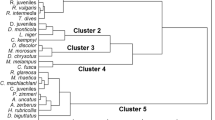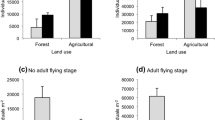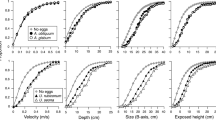Abstract
Cues involved in determining the distribution of invertebrate propagules within a stream landscape contribute greatly to our knowledge of the supply and arrangement of new recruits and thus an improved understanding of factors that might ultimately affect population parameters. Previous observations indicated that both current velocity and rock size were important determinants of the egg mass distribution of certain hydrobiosid caddis flies that lay their eggs in single masses beneath emergent rocks. These observations were tested experimentally in a temperate, upland Australian stream. Manipulations of current speed confirmed that females of Ulmerochorema sp. and the Taschorema complex deposited more eggs on rocks in elevated current speeds (>0.40 ms−1) whereas Apsilochorema sp. deposited more eggs on rocks in slow currents (<0.30 ms−1). This latter result did not coincide with previous observational data. The anomaly between observational and experimental data, however, was reconciled by the outcome of a further experiment that tested the influence of the emergent or 'landing pad' size of rocks as the abundance of Apsilochorema egg masses increased with landing pad size independent of the prevailing flow conditions. Landing pad size did not influence the abundance of egg masses of Taschorema or Ulmerochorema. Patterns of female visits to rocks indicated that taxa might distinguish between favoured egg-laying sites prior to landing on rocks. Large aggregations of adult male and female Ulmerochorema collected from rocks favoured for oviposition provide indirect evidence for mating induced swarming behaviour associated with oviposition site selection. This study provides a framework for more sophisticated questions relating to the influence of oviposition site selection on structuring populations of lotic macroinvertebrates.




Similar content being viewed by others
References
Badcock RM (1953) Observation of oviposition under water of the aerial insect Hydropsyche angustipennis (Curtis) (Trichoptera). Hydrobiologia 5:222–225
Berendonk TU, Bonsall MB (2002) The phantom midge and a comparison of metapopulation structures. Ecology 83:116–128
Biermann HC, Schinner GO, Strathmann RR (1992) Influence of solar radiation, microalgal fouling, and current on deposition site and survival of embryos of a droid nudibranch gastropod. Mar Ecol Prog Ser 86:205-215
Bouckaert FW, Davis J (1998) Microflow regimes and the distribution of macroinvertebrates around stream boulders. Freshw Biol 40:77–86
Cooperband MF, Vinson SB (2000) Host-acceptance requirements of Melittobia digitata (Hymenoptera: Eulophidae), a parasitoid of mud dauber wasps. Biol Cont 17:23–28
Coupland JB (1991) Oviposition response of Simulium reptans (Diptera: Simuliidae) to the presence of conspecific eggs. Ecol Entomol 16:11–15
Dean JC (1997) Larvae of the Hydrobiosidae (Insecta: Trichoptera). In: Hawking JH (ed) Identification guide series, vol 11. Co-operative Research Centre for Freshwater Ecology, Albury
Deutsch WG (1984) Oviposition of Hydropsychidae (Trichoptera) in a large river. Can J Zool 62:1988–1994
Doeg TJ, Milledge GA (1991) Effect of experimentally increasing concentrations of suspended sediment on macroinvertebrate drift. Aust J Mar Freshw Res 42:519–526
Doeg TJ, Lake PS, Marchant R (1989a) Colonization of experimentally disturbed patches by stream macroinvertebrates in the Acheron River, Victoria. Aust J Ecol 14:207–220
Doeg TJ, Marchant R, Douglas M, Lake PS (1989b) Experimental colonisation of sand, gravel and stones by macroinvertebrates in the Acheron River, southeastern Australia. Freshw Biol 22:57–64
Downes BJ, Glaister A, Lake PS (1997) Spatial variation in the force required to initiate rock movement in 4 upland streams: implications for estimating disturbance frequencies. J N Am Benthol Soc 16:203–220
Downes BJ, Lake PS, Glaister A, Webb JA (1998) Scales and frequencies of disturbances: rock size, bed packing and variation among upland streams. Freshw Biol 40:625–639
Duffield RM, Flint OS, Nelson CH (1994) Glossosoma verdona (Glossosomatidae: Trichoptera) in the diet of brook trout (Salvelinus fontinalis) in Libby Creek, Wyoming, USA. J Kans Entomol Soc 67:277–282
Epel D, Hemela K, Shick M, Patton C (1999) Development in the floating world: defenses of eggs and embryos against damage from UV radiation. Am Zool 39:271–278
Gibbons WG, Pain D (1992) The influence of river flow rate on the breeding behaviour of Calopteryx damselflies. J Anim Ecol 61:283–289
Golini VI, Davies DM (1975) Relative response to colored substrates by ovipositing blackflies (Diptera:Simuliidae). I. Oviposition by Simulium (Simulium) verecundum Stone and Jamnback. Can J Zool 53:521–535
Gordon HA, McMahon TA, Finlayson BF (1992) Stream hydrology: an introduction for ecologists. Wiley, Chichester
Holomuzki JR (1991) Macrohabitat effects on egg deposition and larval growth, survival, and instream dispersal in Ambystoma barbouri. Copeia 3:687–694
Horvath G (1995) Reflection polarization patterns at flat water surfaces and their relevance for insect polarization vision. J Theor Biol 175:27–37
Horvath G, Bernath B, Molnar G (1998) Dragonflies find crude oil visually more attractive than water: multiple-choice experiments on dragonfly polartaxis. Naturwissenschaften 85:292–297
Huk T, Kuhne B (1999) Substrate selection by Carabus clatratus (Coleoptera: Carabidae) and its consequences for offspring development. Oecologia 121:348–354
Jaenike J, Holt RD (1991) Genetic evidence for habitat preference: evidence and explanations. Am Nat 137:S67-S90
Jordan J, Lake PS (1996) Grazer-epilithon interactions in an Australian upland stream. Mar Freshw Res 47:831–835
Kostal V, Finch S (1994) Influence of background on host-plant selection and subsequent oviposition by the cabbage root fly (Delia radicum). Entomol Exp Appl 70:153–163
Kouki J (1993) Female's preference for oviposition site and larval performance in the water-lily beetle, Galerucella nymphaeae (Coleoptera: Chrysomelidae). Oecologia 93:42–47
Kriska G, Horvath G, Andrikovics S (1998) Why do mayflies lay their eggs en mass on dry asphalt roads? Water-imitating polarized light reflected from asphalt attracts Ephemeroptera. J Exp Biol 201:2273–2286
Martin WW (1991) Egg parasitism by zoosporic fungi in a littoral chironomid community. J N Am Benthol Soc 10:455–462
Mayhew PJ (1997) Adaptive patterns of host-plant selection by phytophagous insects. Oikos 79:417–428
Millar JG, Chaney JD, Beehler JW, Mulla MS (1994) Interaction of the Culex quinquefasiatus egg raft pheromone with a natural chemical associated with oviposition sites. J Am Mosq Cont Assoc 10:374–379
Nebioss A (1992) Illustrated keys to the families and genera of Australian Trichoptera. Australian Society for Limnology, Abbotsford
Orians GH, Wittenberger JF (1991) Spatial and temporal scales in habitat selection. Am Nat 137:S29-S49
Otto C (1987) Adaptive egg laying behaviour in two species of caddisflies. In: Bournaud M, Tachet H (eds) Proceedings of the 5th international symposium on Trichoptera. Junk, Dordrecht, pp 171–174
Peckarsky BL, Taylor BW, Caudill CC (2000) Hydrologic and behavioural constraints on oviposition of stream insects: implications for adult dispersal. Oecologia 125:186–200
Rausher MD (1979) Larval habitat suitability and oviposition preference in three related butterflies. Ecology 60:503–511
Rawlings TA (1999) Adaptations to physical stress in the intertidal zone: the egg capsules of neogastropod molluscs. Am Zool 39:230–243
Rehfeldt GE (1992) Aggregation during oviposition and predation risk in Sympetrum vulgatum L. (Odonata: Libellulidae). Behav Ecol Sociobiol 30:317–322
Reich P (2002) The egg masses of lotic invertebrates: proximate cues for oviposition site selection and implications for larval abundance and distribution. PhD thesis, The University of Melbourne, Melbourne
Reich P, Downes BJ (2003) The distribution of aquatic invertebrate egg masses in relation to physical characteristics of oviposition sites at two Victorian upland streams. Freshw Biol(in press)
Resetarits WJ (1996) Oviposition site choice and life history evolution. Am Zool 36:205–215
Rosenheim JA (1999) Characterizing the cost of oviposition in insects: a dynamic model. Evol Ecol 13:141–165
Schmid PE (1992) Population dynamics and resource utilization by larval Chironomidae (Diptera) in a backwater area of the River Danube. Freshw Biol 28:111–127
Schreiber ESG (1995) Long-term patterns of invertebrate stream drift in an Australian temperate stream. Freshwater Biol 33:13–25
Seymour RS (1999) Respiration of aquatic and terrestrial amphibian embryos. Am Zool 39:261–270
Singer MC, Ng D, Thomas CD (1988) Heritability of oviposition preference and its relationship to offspring performance within a single insect population. Evolution 42:977–985
Siva-Jothy MT, Gibbons DW, Pain D (1995) Female oviposition-site preference and egg hatching success in the damselfly Calopteryx splendens xanthosstoma. Behav Ecol Sociobiol 37:39–44
Sjerps M, Haccou P, Meelis E, Van Der Meijden E (1993) Egg distribution within patches: an optimality problem for insects. Theor Popul Biol 43:337–367
Solarz SL, Newman RM (1996) Oviposition specificity and behaviour of the watermilfoil specialist Euchrychiopsis lecontei. Oecologia 106:337–344
Spencer M, Blaustein L, Cohen JE (2002) Oviposition habitat selection by mosquitoes (Culiseta longiareolata) and consequences for population size. Ecology 83:669–679
Strathmann RR, Hess HC (1999) Two designs of marine egg masses and their divergent consequences for oxygen supply and desiccation in air. Am Zool 39:253–260
Tokeshi M, Reinhardt K (1996) Reproductive behaviour in Chironomus anthracinus (Diptera: Culicidae), with a consideration of the evolution of swarming. J Zool 240:103–112
Wiklund C (1977) Oviposition, feeding and spatial separation of breeding and foraging habitats in a population of Leptidea sinapis (Lepidoptera). Oikos 28:56–68
Wiklund C (1981) Generalist vs specialist oviposition behaviour in Papilio machaon (Lepidoptera) and functional aspects on the hierarchy of oviposition preferences. Oikos 36:163–170
Acknowledgements
Thanks to George Perry, Joey Boothby and Karin Reich for help with fieldwork. This research was funded by a University of Melbourne Postgraduate Scholarship and a fieldwork travel grant awarded to P.R. by the School of Anthropology, Geography & Environmental Studies and Australian Research Council funding awarded to B.J.D. We also thank two anonymous reviewers for their constructive comments.
Author information
Authors and Affiliations
Corresponding author
Rights and permissions
About this article
Cite this article
Reich, P., Downes, B.J. Experimental evidence for physical cues involved in oviposition site selection of lotic hydrobiosid caddis flies. Oecologia 136, 465–475 (2003). https://doi.org/10.1007/s00442-003-1284-6
Received:
Accepted:
Published:
Issue Date:
DOI: https://doi.org/10.1007/s00442-003-1284-6




